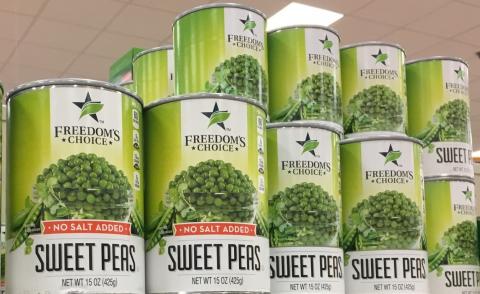CANNED DELIGHT: The military community has long-standing love affair with food packaged in these historic containers

NOTE: Click here to see a DeCA video about the history of the military’s relationship with canned goods.
FORT LEE, Va. – For hundreds of years, getting fresh food to the troops was a complicated undertaking for military supply chains, especially for fruits and vegetables.
In the early nineteenth century, the food industry solved the problem with the invention of the canning process, an innovation that has led to some of the packaging enjoyed today by troops in the field and customers at home.
The journey to canned foods began in 1803 when Frenchman, Nicolas Appert, came up with a way to seal food in airtight champagne bottles. These sealed champagne bottles of food were sent out to sea with the French Navy – and they loved it.
In 1810 an Englishman named Peter Durand patented the idea of sealing cooked food in tin cans to preserve it.
In 1916, nutritionist Caroline Hunt wrote a guide for the United States Department of Agriculture (USDA) that grouped foods together and explained how much of each food group should be consumed each day. The guide recommended two-four servings of fruit each day.
By the time the U.S. entered the Korean War, the importance of fruit in the diet was widely known, and fruit and fruit juices began appearing in rations. This included canned peaches, pears and apricots, canned apple juice and apple sauce, as well as canned fruit cocktail. Today military MREs contain dried fruit and mixed fruit in syrup as well as fruit desserts.
During World War II, Chef Hector Boiardi catered to the troops who loved pasta when his company, Chef Boyardee, won a contract to ship millions of cans of spaghetti and meatballs to the troops. Even though the pasta came in the drab, olive green cans, the soldiers couldn’t get enough of it.
From World War I to modern day, a number of manufacturers have supplied troops overseas. George Hormel’s food and canning company, for example, shipped hundreds of millions of cans of SPAM, Veal Loaf and chopped pork and eggs to the troops.
World War II was the turning point with many of these commercial companies transforming their factories to mass produce meals for the troops. After the war, items such as powdered cheeses, instant drinks and cured meats went from being developed for troop rations to kitchen tables.
“If you need quality canned foods look no further than your local commissary for the best choices that also save you money,” Saucedo said.
-DeCA-
PHOTO CAPTION: Canned goods, like these Freedom’s Choice items from the commissary, have been a staple of troops’ diet throughout history. (DeCA photo)
About DeCA: The Defense Commissary Agency operates a worldwide chain of commissaries providing groceries to military personnel, retirees and their families in a safe and secure shopping environment. Commissaries provide a military benefit, saving authorized patrons thousands of dollars annually on their purchases compared to similar products at commercial retailers. The discounted prices include a 5-percent surcharge, which covers the costs of building new commissaries and modernizing existing ones. A core military family support element, and a valued part of military pay and benefits, commissaries contribute to family readiness, enhance the quality of life for America’s military and their families, and help recruit and retain the best and brightest men and women to serve their country.
